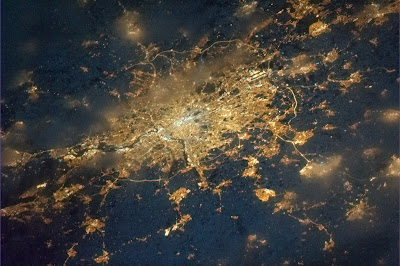 |
| The bright lights of Europe spilling into the night as seen from the Space Station. |
Light pollution around the world has expanded exponentially in recent decades and now it is reckoned that the vast majority people across Western Europe and the United States no longer experience a truly dark night.
Night's natural darkness is invaluable for our spiritual health and the health of the natural world and as a consequence every living creature, including ourselves, suffers from its loss.
Like the advancement of technology it is one of those things that changes subtly against the backdrop of busy lives – and almost without noticing we become accustomed to a new ‘normal'.
In his book, Bogard investigates the meaning of darkness and travels to some of the world's intensely lit cities - from Paris, the ‘city of light' to glittering Las Vegas and to still gas-lit streets of London's Westminster district, meeting an inimitable range of characters along the way.
Bogard contrasts the skies above our cities and urban populations to some of the most remote and darkest places on the globe, like the great national parks in America and the Island of Sark off the British coast.
He discusses how light is negatively affecting the natural world, how our well-being is significantly influenced by darkness or its lack, and how it's not a matter of using light at night or not, but rather when and where, how and how much.
Travelling the world looking for dark skies, Bogard considers our affinity for artificial light, the false sense of security it provides, and its implications.
He covers such broadly diverse issues as the health impacts of working the night-shift to the persecution of bats, and urges the reader to weigh the ramifications of light pollution and our failure to address them.
 |
| The growth of light piollution across the United States, including a projection for the year 2025. |
"We think that because of television, the internet, or jet travel we see a lot of the planet," says Bogard.
"But the only chance we really have to retain our sense of the scale in the real universe is by looking at the night sky."
As we approach the winter solstice when the dark nights of the northern hemisphere reach their longest, what better time to delve into such a book?
Bogard's evocation of the night blends environmental and cultural history to make reading about light pollution a surprising pleasure.
By reclaiming the night we stand only to gain. Not least in decreased energy costs and redressing the balance of life but also in that other fast-disappearing phenomenon - wonder.
Bogard draws attention to the naturally dark night as a landscape in its own right - a separate, incredibly valuable environment that we overlook and destroy at our own peril.
‘The End of Night’ by Paul Bogard
is published by Fourth Estate and
is available at your local bookshop
or from Amazon.























